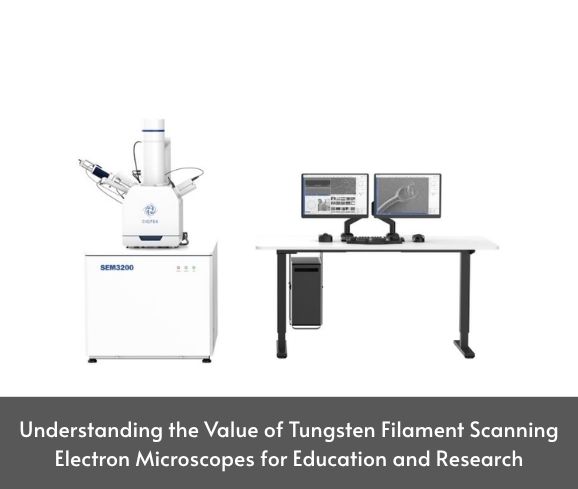Why Educational Institutions Use Tungsten Filament Scanning Electron Microscopes
Educational institutions prioritize tools that balance performance, durability, and affordability. The tungsten filament scanning electron microscope (SEM) meets these criteria, making it an ideal choice for teaching and research. Its robust design and reliable performance allow students and researchers to explore material structures without the high costs associated with more advanced SEM types.
Hansvue provides tungsten filament SEMs that are tailored for educational settings, ensuring that institutions can equip their laboratories with reliable instruments that facilitate hands-on learning and research.
How Students Learn Electron Microscopy Using Tungsten Filament SEMs
Hands-on experience is crucial in scientific education. Tungsten filament SEMs offer students the opportunity to learn about electron microscopy’s principles and applications directly. By operating these microscopes, students gain insights into sample preparation, imaging techniques, and data analysis.
The user-friendly interface of Hansvue’s SEMs ensures that students can focus on learning the scientific concepts without being hindered by complex equipment. This practical exposure prepares students for future research and industry roles where SEM skills are valuable.
Affordability of the Tungsten Filament Scanning Electron Microscope for Universities
Budget constraints are a common challenge for educational institutions. Tungsten filament SEMs are more affordable than their field emission counterparts, making them accessible to universities and colleges. Their lower initial cost and maintenance requirements mean that institutions can allocate resources to other critical areas of education and research.
Hansvue’s commitment to providing cost-effective solutions ensures that educational institutions can invest in quality equipment without compromising on performance.
Hands-on Training with the Tungsten Filament Scanning Electron Microscope
Practical training is essential for students to grasp complex scientific concepts. Tungsten filament SEMs are designed for ease of use, allowing students to operate the equipment confidently. This hands-on experience reinforces theoretical knowledge and enhances students’ understanding of material analysis.
Hansvue offers comprehensive training and support, ensuring that educators and students can maximize the benefits of their SEMs. This support includes user manuals, training sessions, and responsive customer service.
Features That Make the Tungsten Filament Scanning Electron Microscope Ideal for Learning
Several features make tungsten filament SEMs particularly suitable for educational purposes:
Durability: Designed to withstand frequent use in teaching labs.
Ease of Maintenance: Simplified maintenance procedures reduce downtime and learning interruptions.
User-Friendly Interface: Intuitive controls facilitate student learning and experimentation.
Versatility: Capable of analyzing a wide range of materials, supporting diverse curricula.
Hansvue’s SEMs incorporate these features, ensuring that educational institutions have reliable and effective tools for teaching and research.
Getting a Tungsten Filament Scanning Electron Microscope for Your Institution
Acquiring a tungsten filament SEM from Hansvue is a straightforward process. Institutions can consult with Hansvue’s experts to determine the best model for their specific needs and budget. Hansvue provides comprehensive support throughout the purchasing process, including installation, training, and ongoing maintenance services.
By partnering with Hansvue, educational institutions can enhance their scientific programs with reliable and cost-effective SEM solutions.
Conclusion
Tungsten filament scanning electron microscopes are invaluable tools for education and research. Their affordability, durability, and user-friendly design make them ideal for teaching laboratories and academic institutions. Hansvue’s commitment to providing high-quality SEMs ensures that educators and students have access to the tools they need to explore the microscopic world effectively.










